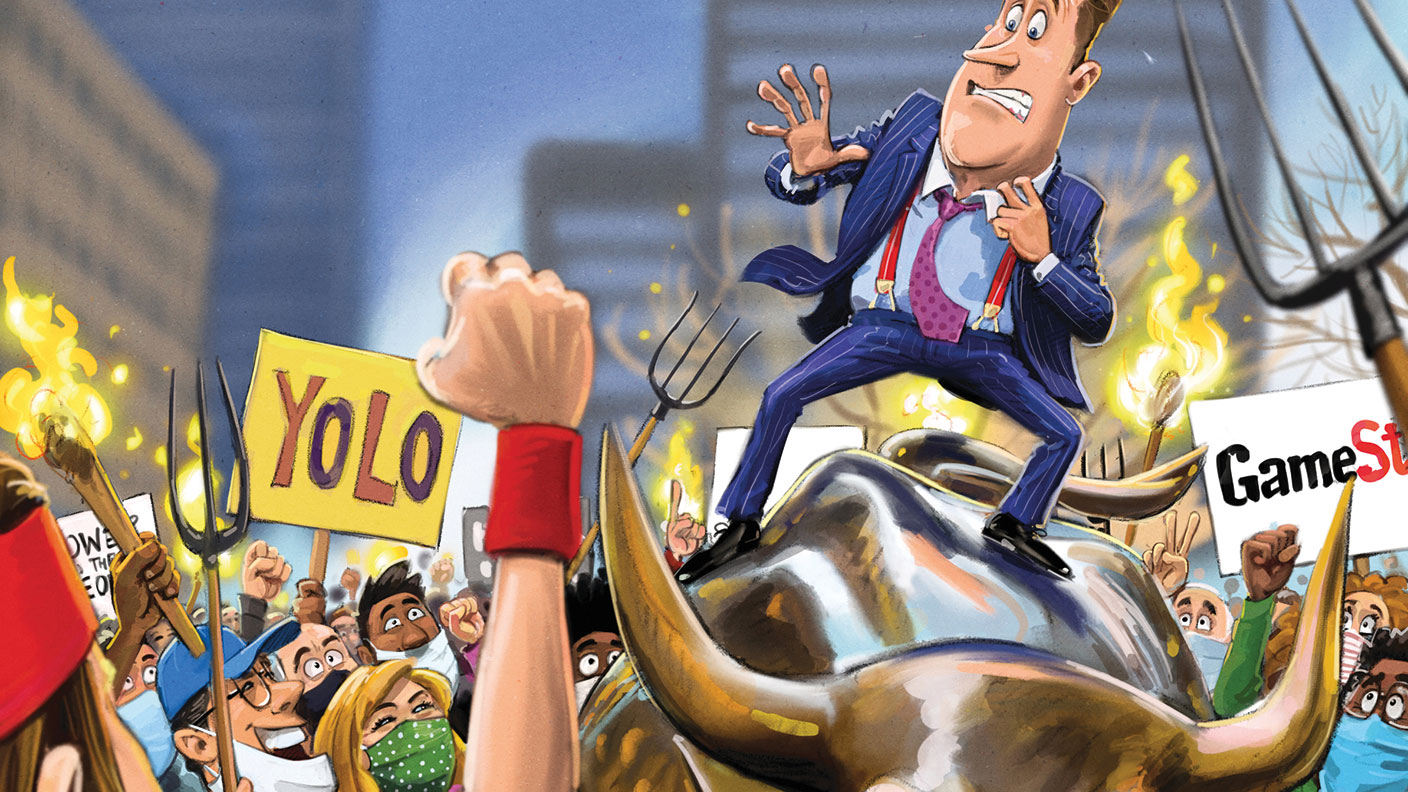GameStop, short-sellers, Reddit rebels and Wall Street’s wonky plumbing
What was the furore over US retailer GameStop really about? Is silver the next big social media-driven trade? And what does any of this mean for sensible long-term investors? John Stepek tries to unravel the story.


You have to hand it to them. They had a good go at giving the suits a run for their money. But now it seems that the army of ordinary speculators (more than eight million at last count) who banded together on social-media site Reddit under the “r/wallstreetbets” bulletin board, has been defeated. “Buy and HODL” was the battle cry. But as of the time of writing, GameStop – the original battleground stock – has slid from a peak above $400 to below $100, while other target stocks have also tumbled. Meanwhile, in the commodities market, silver spiked on rumours that it was next, then tumbled as rapidly as it had gone up. Is the dream in ruins? Has “The Man” crushed the little guy once again, or is this about something else altogether? Let’s start by looking at what actually happened here.
Revenge of the value investors
The first thing to understand is that despite the popular narrative, this didn’t start out as a grand rebellion against “the suits”. It started out as a value investment. GameStop is a struggling video-games retailer, with around 5,500 physical branches, mostly in the US. You don’t have to be a financial analyst to see that this is a weak business model in an era in which computer games are already widely downloaded online (via platforms such as Steam). Throw in Covid-19’s impact on high-street shopping, and you have a recipe for disaster. So it’s little wonder that many people saw the stock as a classic “short” (where investors bet on the price falling rather than rising). The share price went from being around $30 a share in early 2016, to below $5 by last summer.
However, even a bad business may have some value left in it, assuming you can get hold of it at the right price. And some value investors saw GameStop as a potential turnaround play. That’s what 34-year old Keith Gill – or DeepF**kingValue, as he is known on r/wallstreetbets – reckoned as long ago as June 2019. He started investing in GameStop’s shares then, when the price was around $5. As The Wall Street Journal reports, “he saw potential for the struggling retailer to reinvigorate itself by attracting new customers with the latest video-game consoles”. Other investors, says Gill, had written off GameStop as the next Blockbuster. “It appeared many folks just weren’t digging in deeper. It was a gross misclassification of the opportunity.”
MoneyWeek
Subscribe to MoneyWeek today and get your first six magazine issues absolutely FREE

Sign up to Money Morning
Don't miss the latest investment and personal finances news, market analysis, plus money-saving tips with our free twice-daily newsletter
Don't miss the latest investment and personal finances news, market analysis, plus money-saving tips with our free twice-daily newsletter
You’ll note that Gill is neither a bored teenager, sitting on his government stimulus cheque, nor a desperate man out to get revenge on “the Street”. In fact, he was a financial adviser with a Chartered Financial Analyst qualification, who also ran a YouTube channel on finance under the name of “Roaring Kitty”. He had a sensible – if risky – thesis on GameStop, and he wasn’t the only one. Noted short-seller Michael Burry (who became famous for betting against mortgage-backed securities before the 2008 crash, thus earning a starring role in Michael Lewis’ book, The Big Short) also bought GameStop in 2019, for similar reasons. Then, in the middle of 2020, with the share price down to around $4, activist investor Ryan Cohen bought into the stock. In November he started putting pressure on the company’s management, asking for a seat on the board, to help drive through the turnaround plan (mostly getting rid of the physical branches and moving online).
So GameStop started out as a pure value investment. And it was working. By the end of 2020, all that turnaround talk had driven the price up from $4 in summer 2020 to above $20. A 400% gain in six months – not to be sniffed at. But what happened next? How did the share price go from $20 to more than $400 at one point, during the trading frenzy of January? That’s where David and Goliath come in.
Reckless short-sellers
As we’ve already noted, GameStop looked like a dud company for lots of reasons. So short-sellers had been betting heavily that the share price would fall, and as the price rose they started to bet even more heavily against it. Here’s a quick primer on how shorting works (there’s a lot more at the MoneyWeek website). If you want to short a stock, you have to borrow it first. You then sell it. You then hope that the price falls. If the price falls, then you’ll be making a profit on paper. At this point, you can close the short position by buying the shares back and returning them to the original owner. You keep the profit you made (the difference between the price at which you sold and the price at which you bought). If the price rises, however, you’ll be losing money on paper. At this point, you can hang on and hope it goes down. But if it keeps rising, eventually you’ll hit a point where you’re forced to sell because your paper losses are just too big to sustain.
There were two main drivers of the wild surge in the price of GameStop and unlike the original “value” investment neither had anything to do with the company’s fundamentals. The first was a “short squeeze”. Remember – when you short stock, you have to borrow it. The short-sellers got so excited about GameStop that they collectively borrowed more shares than were actually in issue – “short interest” reached 140% at one point. This is public information and it left the hedge funds who were short in a very exposed position. Indeed, some have argued convincingly that it was a colossal failure of risk management on their part. Why? Because if prices move higher, then many short-sellers will be forced to close their positions by buying the stock, which in turn drives prices higher, triggering more pain for the remaining short-sellers, and so on. Given the sheer volume of short interest in this case, the risk of a vicious upwards spiral should have been obvious.
However, the sheer violence of this move was due to something even more obscure – a “gamma” squeeze. To cut a long and technical story short, this is all about options activity around the company. An option gives you the right to buy (a “call” option) or sell (a “put” option) a share at a specific price, within a specific time frame. The broker who sells you this option then has to hedge their own exposure by buying or shorting the underlying shares. Put very simply, the big move in GameStop’s share price and activity around the share created a lot of forced buying by brokers who needed to buy more shares to hedge their option exposure.
Meanwhile, of course, as the price was rising, the r/wallstreetbets group were getting more and more excited and buying even more – some with the hope of profit, some for a laugh and camaraderie, most with both – and this exacerbated the whole move. As a result of the price spike, Melvin Capital Management – the most prominent hedge fund involved – lost 53% in January alone and had to raise $2.75bn in funds from fellow hedge funders Steve Cohen of Point72 and Ken Griffin of Citadel. Other losers included a hedge fund called Maplelane Capital, which lost 45%.
So much for “power to the people”
But it’s what happened next that really cemented the David versus Goliath narrative. A lot of the people betting on the stock (and other heavily shorted companies such as cinema chain AMC) were using free-to-trade brokers and apps such as Robinhood. These apps don’t charge investors anything to trade. Instead they make their money by selling the order flow to market makers, who in turn execute the trades and pocket the difference between the buying and the selling price (the “spread”). This is a controversial practice because of questions over whether or not it means small investors get their trades executed at the best price – as always, “free” doesn’t mean “free”, it just means it costs you at another point in the process...
To read the whole of this article, subscribe to MoneyWeek magazine
Subscribers can see the whole article in the digital edition available here
Get the latest financial news, insights and expert analysis from our award-winning MoneyWeek team, to help you understand what really matters when it comes to your finances.
John Stepek is a senior reporter at Bloomberg News and a former editor of MoneyWeek magazine. He graduated from Strathclyde University with a degree in psychology in 1996 and has always been fascinated by the gap between the way the market works in theory and the way it works in practice, and by how our deep-rooted instincts work against our best interests as investors.
He started out in journalism by writing articles about the specific business challenges facing family firms. In 2003, he took a job on the finance desk of Teletext, where he spent two years covering the markets and breaking financial news.
His work has been published in Families in Business, Shares magazine, Spear's Magazine, The Sunday Times, and The Spectator among others. He has also appeared as an expert commentator on BBC Radio 4's Today programme, BBC Radio Scotland, Newsnight, Daily Politics and Bloomberg. His first book, on contrarian investing, The Sceptical Investor, was released in March 2019. You can follow John on Twitter at @john_stepek.
-
 Taxpayers urged to fight automated HMRC penalties as 20,000 win on appeal
Taxpayers urged to fight automated HMRC penalties as 20,000 win on appealHMRC loses more than 60% of cases when taxpayers appeal an automated penalty it has imposed, new figures show.
-
 More than five million taxpayers overpay with wrong tax codes – how to check yours is right
More than five million taxpayers overpay with wrong tax codes – how to check yours is rightHMRC overcharged taxpayers £3.5 billion in income tax the latest data shows, with tax coding errors largely to blame. Accountants say it is “essential” people check their tax codes to avoid being hit with higher bills.
-
 Profit from pest control with Rentokil Initial
Profit from pest control with Rentokil InitialRentokil Initial is set for global expansion and offers strong sales growth
-
 Three funds to buy for capital growth and global income
Three funds to buy for capital growth and global incomeOpinion Three investment trusts with potential for capital growth, selected by Adam Norris, co-portfolio manager of the CT Global Managed Portfolio Trust
-
 Fine-art market sees buyers return
Fine-art market sees buyers returnWealthy bidders returned to the fine-art market last summer, amid rising demand from younger buyers. What does this mean for 2026?
-
 PayPoint: a promising stock for income-seekers
PayPoint: a promising stock for income-seekersPayPoint, a household name across Britain, is moving away from its traditional roots toward a digital future. Investors after a steady income should buy in
-
 Investing in forestry: a tax-efficient way to grow your wealth
Investing in forestry: a tax-efficient way to grow your wealthRecord sums are pouring into forestry funds. It makes sense to join the rush, says David Prosser
-
 The MoneyWeek investment trust portfolio – early 2026 update
The MoneyWeek investment trust portfolio – early 2026 updateThe MoneyWeek investment trust portfolio had a solid year in 2025. Scottish Mortgage and Law Debenture were the star performers, with very different strategies
-
 Pundits had a bad 2025 – here's what it means for investors
Pundits had a bad 2025 – here's what it means for investorsThe pundits came in for many shocks in 2025, says Max King. Here is what they should learn from them
-
 The MoneyWeek ETF portfolio – early 2026 update
The MoneyWeek ETF portfolio – early 2026 updateThe MoneyWeek ETF portfolio had a solid year in 2025 and looks well placed for what the next 12 months may bring
